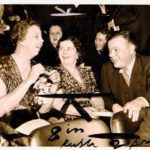Rose Schneiderman (center) with Eleanor Roosevelt and David Dubinsky, 1938. YIVO Institute for Jewish Research. Link.
Rose Schneiderman: The Red Rose of Anarchy
by Anna Khomina, Research and Special Projects Intern, Center for Jewish History
A public speaker, union leader, and political adviser, Rose Schneiderman devoted her life to fighting for working class rights. Active from 1904 through the 1950s, Schneiderman was forced to drop out of school at age 13 to support a widowed mother and three younger siblings. Three years later, she moved up to being a cap maker and, frustrated by the lack of female advancement in the shop, she became an active member of the United Cloth Hat and Cap Makers’ Union, marking her foray into the labor movement. In 1904, at the age of 24, she became vice president of the New York Women’s Trade Union League and participated in the Shirtwaist makers’ strike of 1909-1910, in which 20,000 workers, mostly women, fought for better working conditions and wages. In 1917, she became president of the NYWTUL and of the national WTUL nine years later.
Schneiderman was also active in politics,as a founding member of the Wage Earner’s League for Woman Suffrage in 1911 and a frequent campaigner for protective labor laws for women. She unsuccessfully ran for United States senate in 1920 under the New York State Labor party, but under the Roosevelt administration was named the only female member of the national National Recovery Administration Labor Advisory Board in 1933. This position allowed her to write labor codes for woman-dominated industries as well as contribute to social welfare legislation such as the Social Security, Act, the Fair Labor Standards Act, and the National Labor Relations Act, all significant aspects of the New Deal.
Schneiderman had a close personal relationship with Eleanor Roosevelt that began in 1921, when Eleanor became involved with the NYWTUL. At dinners hosted by the future first lady, Schneiderman had an opportunity to converse with Franklin, and introduced the Roosevelts to the working class world and its struggles, which would play a significant part in FDR’s future New Deal policies. She is pictured above with the first lady in 1938, five years into FDR’s presidency.


